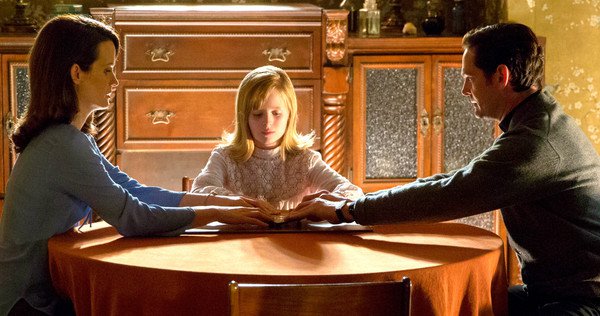Ouija: Origin of Evil (2016)

Ouija: Origin of Evil is one of those franchise entries that many will overlook due to the bad taste left in the mouth of its predecessor. That’s a shame for director Mike Flanagan (Oculus, Hush), as this is a superior film in every respect to the god-awful first entry from 2014, Ouija. Flanagan doesn’t make a sequel so much as a standalone prequel period piece, setting the action in Los Angeles in the year 1967, where we find a widowed scam artist named Alice (Reaser, Hello My Name is Doris), who is working from home as a spiritual medium to make ends meet for herself and her two misfit daughters, fifteen-year-old Lina (Basso, Captain Fantastic) and nine-year-old Doris (Wilson, Deliver Us from Evil).
Inspired by a new ‘board game’ of sorts that has spooked Lina and her friends, Alice decides to incorporate a Ouija board into her flashy séance showcase, but things take a weird turn when it ends up that the device seems to actually be a portal into the spiritual world, one that might put the family in contact with their deceased father/husband. Alas, what they find on the other side is increasingly unnerving, and now young Doris is showing signs of becoming a conduit for malevolent forces to make the leap to the earthly realm.
While hardcore horror-heads may scoff at the PG-13 levels of jolts, resulting in a film that is more atmospherically creepy than downright horrifying. Nevertheless, it is effectively entertaining enough from a surface level standpoint, competently made by craftsman Flanagan with a keen eye for mood, tempo and nifty camera work to generate punchy moments of suspense.
Origin of Evil also benefits from solid casting, especially in Lulu Wilson as young Doris, who treads the line between good-girl adorability and unsettling menace in a way that transcends some of the cartoony elements of the on screen action to make the young girl both sympathetic and menacing, depending on the scene (a veiled threat to Lina’s potential beau about what it’s like to be strangled to death is particularly memorable).
Also quite solid are the mother and sister, portrayed by Elizabeth Reaser and Annalise Basso, respectively. E.T. fans will be delighted to see a meaty supporting role also going to Henry Thomas as Father Tom, the girls’ Catholic school principal who thinks there’s more going on within their house than meets the eye.
The film, just like the setting, represents a more classical approach to horror that seeks to unnerve more than to push the boundaries of gore to get its thrills. It’s an intentional approach by Flanagan, using the old logo from Universal Pictures to introduce the film, as well as its retro title sequence. There are even cue marks that appear in the upper right-hand from time to time, the way that would signal to the projectionist that a reel change is forthcoming during the days of film projected cinemas.
While it may be competent, the film doesn’t do much to break with conventions. It does have a very traditional demonic possession storyline that will be all too familiar to anyone who has seen their share of fright-flicks over the years. It also is limited by typical horror-film logic, whereby the last thing anyone might think of is to flee from the house immediately, or even to call the authorities. The family has no other family to call, any friends to come over who aren’t intended victims, or a sense of history beyond whatever is necessary to set up particular scenes. The possession of Doris is ripped mostly from The Exorcist and its countless imitators, enhanced by not-terribly-seamless CG elements that are a bit too stretchy and rubbery in appearance to seem truly realistic or menacing. Reactions aren’t natural, feigning shock in order to keep the film from becoming overwhelmed by serious-minded terror that could land an R rating, or making it seem like a less entertaining film.
Nevertheless, Flanagan’s compositional instincts on what to show, what not to show, when to make big reveals, and how to properly frame it all is the mark of a very adept filmmaker who has proven to be worth following in small but successful gems like Oculus and Hush over the last couple of years. This is a rare, well crafted and tasteful bump-in-the-night horror film in an age of cheap gimmicks, wanton jump scares, cacophonous shriek-fests, and predictable copycatting of whatever the latest box office hit horror flick cashed in. Ouija: Origin of Evil isn’t worth putting up there among the titles of the new art-house horror that has critics abuzz, such as The Witch, It Follows and The Babadook, but for a conventional old-school fright flick, it’s certainly better than a follow-up to 2014’s Ouija has any right to be.
Qwipster’s rating: B
MPAA Rated: PG-13 for disturbing images, terror and thematic elements
Running Time: 99 min.
Cast: Elizabeth Reaser, Annalise Basso, Lulu Wilson, Henry Thomas, Parker Mack, Doug Jones
Director: Mike Flanagan
Screenplay: Mike Flanagan, Jeff Howard
